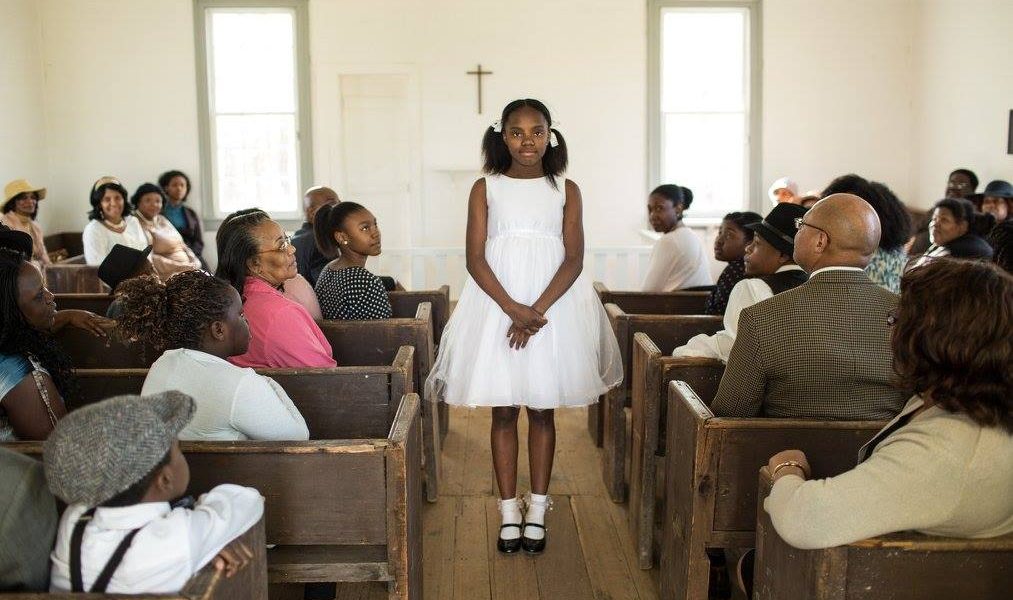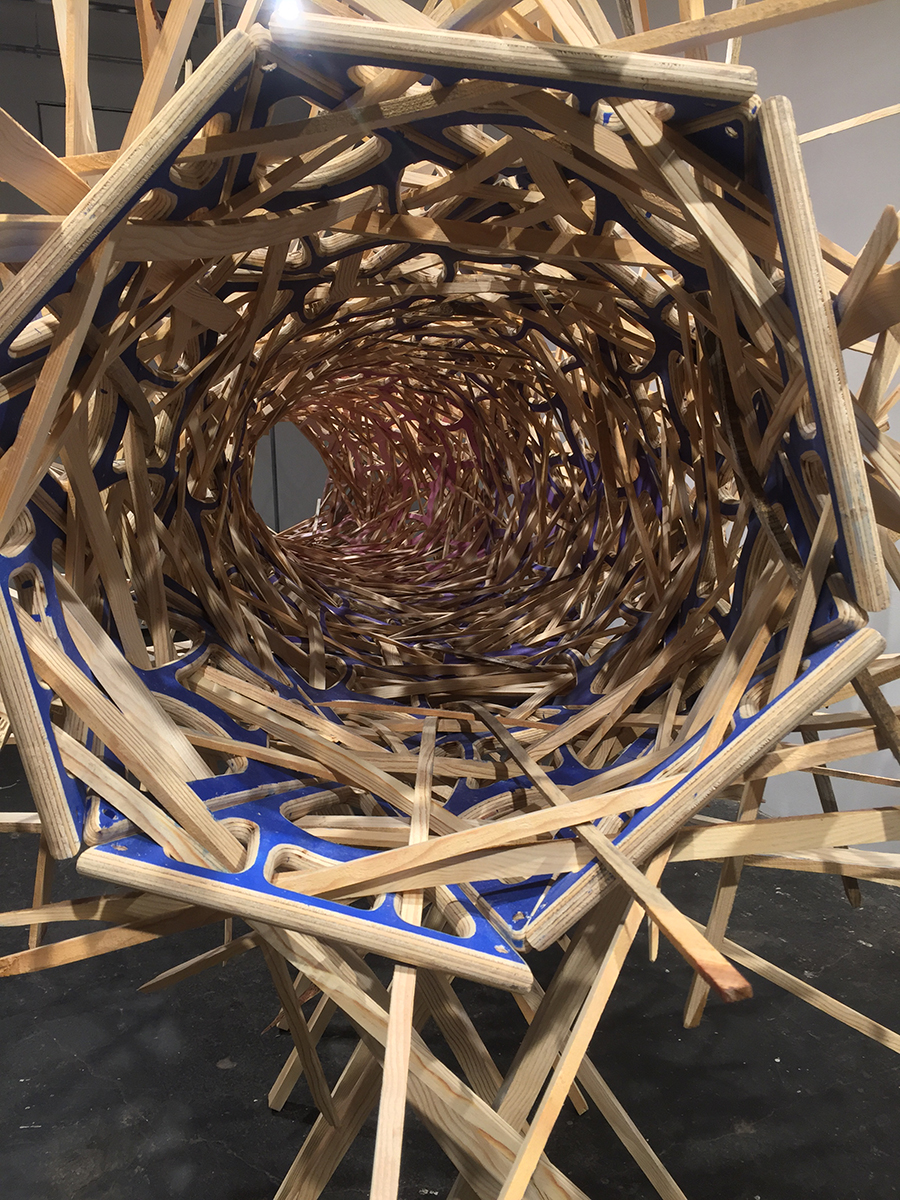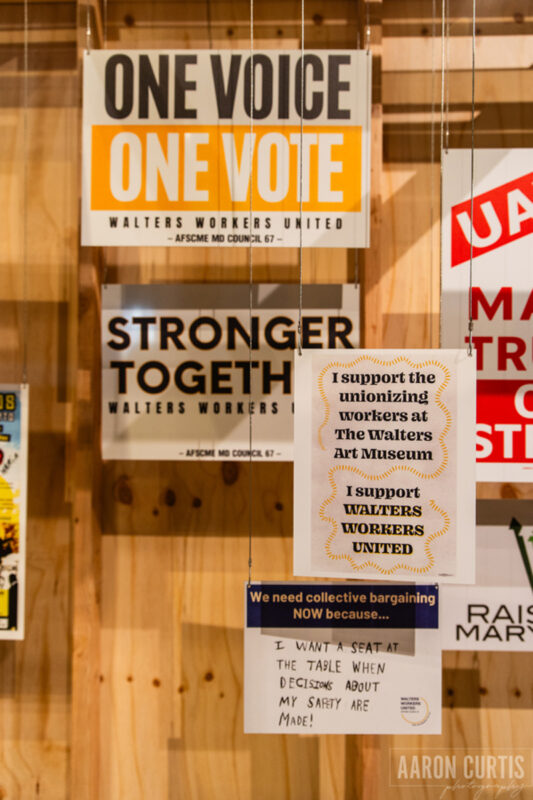Sculpting with Persuasion and Resistance: An Interview with Christian Benefiel by Mike Iacovone
Christian Benefiel’s show Developing an Argument at Flashpoint Gallery is an intricate set of sculptures composed of wood. Each of the three delicate sculptures carry various amounts of tension. As a viewer it’s not clear if they’re about to fall over, or if they’ll stand forever, similar to some of Richard Serra’s work. They command attention in the hallway-like gallery, and occupy the space as individual pieces demanding your inquiries about how they’re made, and how they stand on their own. It begs the question: are they improvised, or meticulously planned?
The largest piece in the exhibit, “A Way Through or Around,” occupies the center of the gallery and allows the viewer to peer into the center of the slightly torqued tunnel that passes through, which allows for a better understanding of the construction. A series of carefully assembled wood pieces make up the skeleton of the work while they are bound together by thin boards bent through and between them.

“Factions of People Certain of What They Believe is Oppression,” which is quite possibly the best title I’ve ever seen, is the smallest piece in the show and made of modular pods connected with wood slats. Its scale in relation to the other pieces is much less imposing; this shouldn’t discount its importance, although it made it feel less important until I spent more time walking around and enjoying the intricacies of the construction, and what must have been in reality, an elaborate plan.
After having the opportunity to speak with Christian about the work, he revealed that there was so much more to these pieces (as there often is) than their formal compositions.
The pieces look both sturdy and fragile. They look methodically constructed, and also chaotically bound together. They look brand-new and also recycled. Are you toeing that line with the intent of highlighting that argument?
Christian Bebefiel: I am, I think that the underlying theme in this work is the balance between absolutes. It is so rare that anyone definitively “wins” in an argument. The elements (both physical and aesthetic) in each piece are in a type of dialogue. When it comes to debate and argument I am a big fan of the Oxford style, where the goal is not to convince people of your stance, but to sway opinion in your favor generally.
It is so rare that anyone definitively “wins” in an argument. The elements (both physical and aesthetic) in each piece are in a type of dialogue. When it comes to debate and argument I am a big fan of the Oxford style, where the goal is not to convince people of your stance, but to sway opinion in your favor generally.
Other dichotomies I am particularly focused on in the design and fabrication of these works is a balance between craft and brutality, Scale and intricacy, and interior/exterior space, as well as natural and synthetic, Structure and collapse, Color balance, etc.
The scale you’re using seems to be leaning towards human sized—big enough for the viewer to walk around and look through, and imposing enough to feel a menacing gruffness that would prevent people from touching. How do you see the sizes of the pieces effecting the way the viewers might experience the show?
The honest answer is that this is really just the scale I am most comfortable working with. I like to build into a space, and to walk around, change perspective and respond at life scale during construction. The scale is in response to the space. They are an obstacle, and a mass in the space, significant, but not impassable, or imposing.
As far as looking through, I think at a certain point there is some self-portraiture in my work, and I am often imagining these pieces as spaces that might actually be occupied by my (or a) body. In construction I am intimately incorporated into the work, and am forced to think about and how my body fits into and feels beyond looking through. There are pretty obvious portals, tunnels etc. in these works, and for the scale of those the opening is passable, but not without some form of struggle or wriggling.

The pieces all seem to be modular, in that they could take somewhat different forms if you were to take them apart and reassemble them. It really felt like something I’d want to take apart and reassemble—like legos. When you’re envisioning them how close does your vision and the reality of the finished piece line up?
I almost always design for a space, the first time that they are installed, and some of the works are more versatile than others. Part of the exciting thing for me in this work is that often I do not see the pieces in entirety until they go up on site. The modularity of the pieces allows some flexibility and customization in each installation, which lets me respond to the space in real time. The drawback is that working with the tension as a primary binder for the work, the same work is never exactly the same from one space to the next.
When assembling, do you consider other iterations?
The structure in these particular pieces is more defined and calculated that some of the works that use found and appropriated objects so the re-installation of them is more formulaic with what I would expect to be similar finished aesthetic. These parts in particular are designed to go together in a very specific way, and might not work if assembled incorrectly.

What is it about the shape of the helix in “A Way Through or Around” that interested you?
It is based around the helical protein structure in viruses and how that is broken when the organism is dying. The pieces form a tight tubular pattern which form a tight structure while still together. They are presented at the moment of breakdown. I was inspired to build this reading about the natural antimicrobial properties of copper and the way in which it naturally and chemically dissolves this outer membrane exposing and draining the cells of other essential elements. There are numerous theories about how and why this happens, here is a brief Wikipedia page about it, but my favorite one is that the conductivity of copper and silver disrupts basic chemical processes at this level which can cause catastrophic failure in these organisms.
While a bit morbid, the science is fascinating, and the longevity of evidence is inspiring. I often look at my work as a type of photograph, a frozen moment where the collapse is imminent. It is a self reflective exercise in which I am forced to confront my own impermanence, which I find somehow more calming as in inevitability than a hypothetical.
This is the idea of the debate as a using elements inherent in opposition argument to undermine their perspective. The piece depicts the point where on element begins to fall apart and open up to scrutiny and disassembly.
—
This show was exhibited at Flashpoint Gallery, 916 G st NW Washington DC March 18 – April 8, 2017.






